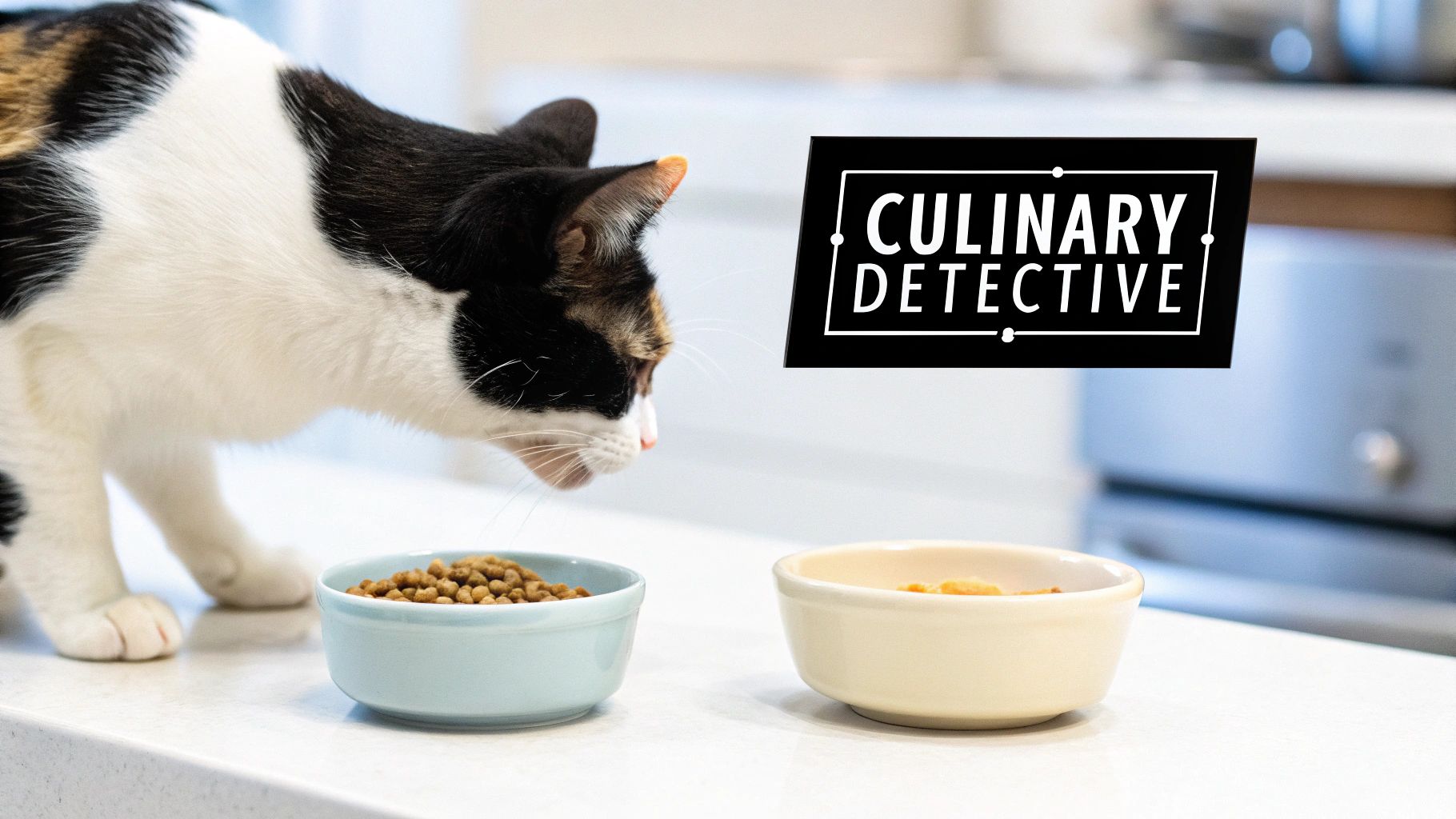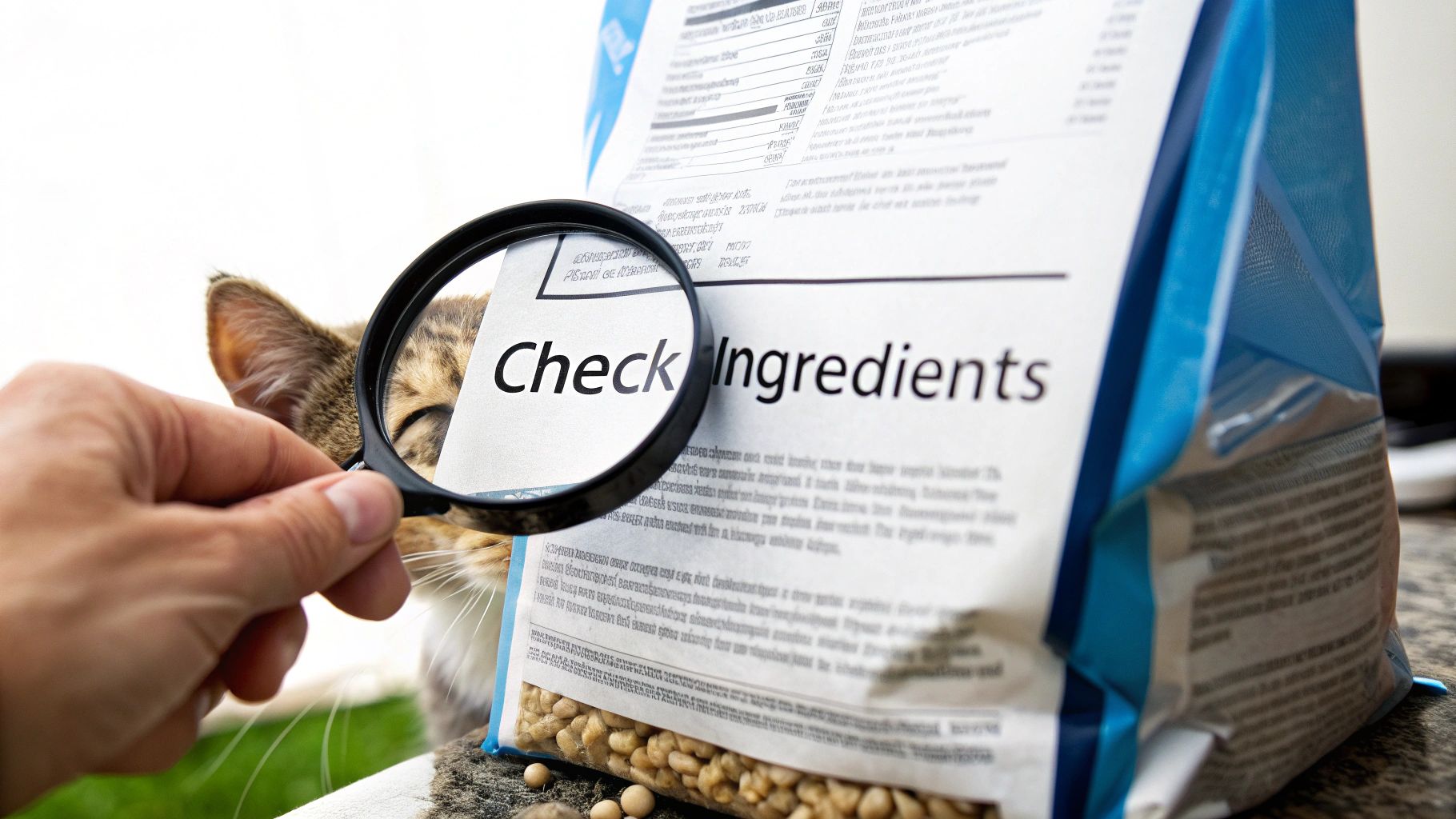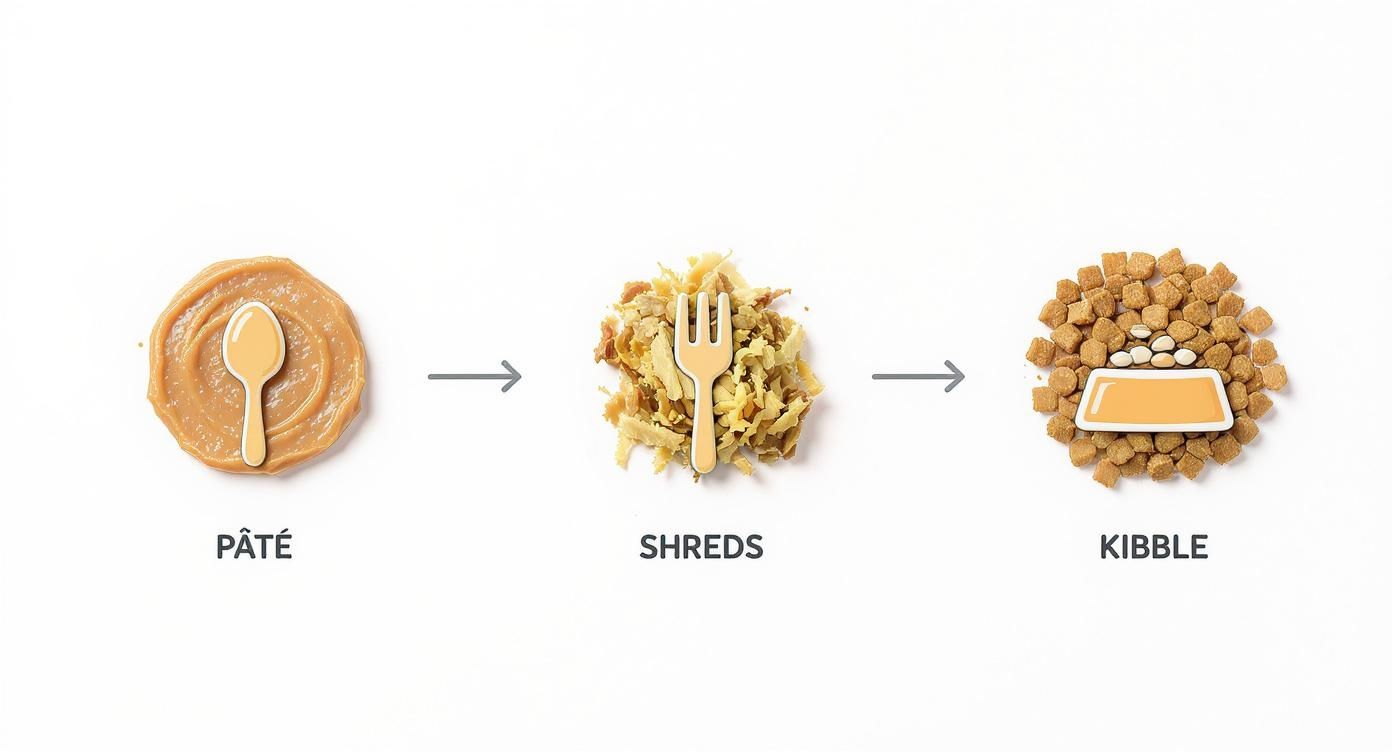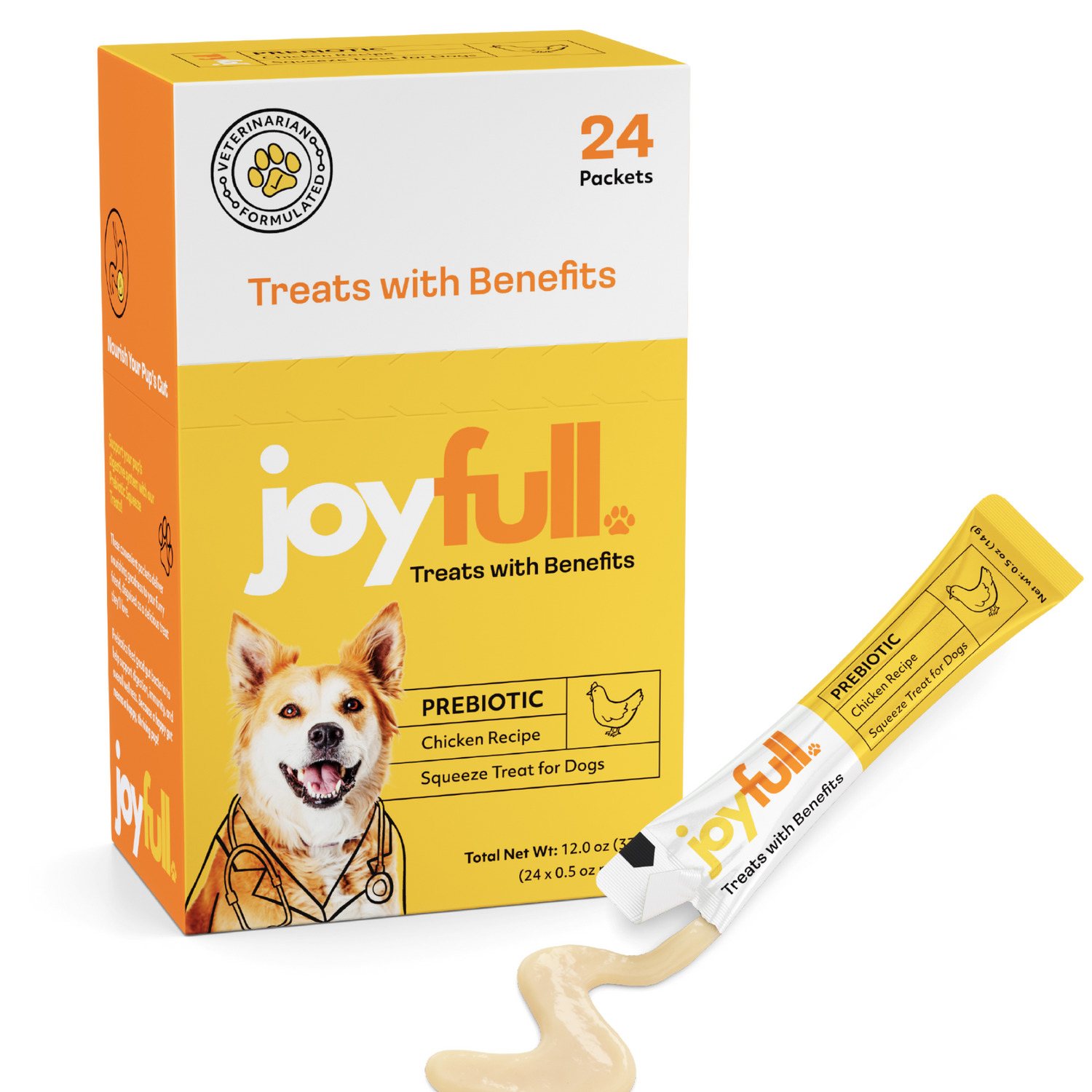
Finding the Best Cat Food for Picky Eaters
The best cat food for picky eaters isn't a one-size-fits-all formula. It’s usually a high-quality wet food with an enticing aroma, a straightforward animal protein like chicken or fish, and a texture your cat actually enjoys—whether that's a smooth pâté or meaty shreds. Since every cat is different, the real secret is learning to think like one.
Why Your Cat Is a Finicky Eater

If you’re pulling your hair out over a finicky cat, know this: you’re not dealing with a stubborn pet. You’re up against thousands of years of evolutionary programming. Cats aren't being difficult just to spite you; their picky habits are hardwired from their days as solitary hunters.
Think of yourself as a feline food detective. Every turned-up nose and ignored bowl is a clue. This isn't just about taste—it's about a complex set of survival instincts that dictate what your cat will and won't eat.
The Ancestral Instincts of a Modern Cat
Underneath that fluffy exterior, your house cat is still a wild hunter at heart. Their ancestors, who were desert-dwelling predators, had to be incredibly cautious to survive. This deeply ingrained wariness shows up at the food bowl in a few key ways.
First, there’s neophobia—a natural fear of anything new. For a wild cat, an unfamiliar food source could be dangerous or even poisonous. That instinct is still alive and well, making your cat hesitate when you suddenly switch up their dinner. Their brain is simply flagging the new food as a potential threat.
Then there's learned aversion, which is a powerful force. If a cat eats something and feels sick later—even if the food wasn't the cause—they can develop a strong, lasting refusal to ever touch it again. It's a classic survival mechanism: "That made me sick once, I'm never risking it again."
Sensory Sensitivities and Preferences
Cats experience the world through their senses, and that’s especially true when it comes to food. Their sense of smell is far more powerful than ours, making aroma the single most important factor for mealtime appeal.
A food that doesn't smell "right" is often rejected before a cat will even consider a taste. This is why gently warming their wet food can work wonders—it releases the aromas and makes the meal smell more like fresh, appealing prey.
Texture and temperature are a big deal, too. Some cats are all about the smooth, uniform consistency of a pâté. Others crave the bite and feel of shreds or chunks in gravy. And food that’s served straight from the fridge? It might be too cold, failing to mimic the body temperature of the fresh prey their instincts tell them to seek out.
As more people treat their pets like family, the demand for specialized foods has skyrocketed. In North America, where about 59% of pet owners have cats, this has created a huge market for premium foods aimed at picky eaters, yet many cat parents still struggle to find something that works.
Understanding these ingrained behaviors helps you approach the problem with more patience. Your cat isn't just being fussy; they’re listening to ancient instincts. To learn more about what your cat truly needs from their diet, dive into our guide on choosing the best protein for cats to start making more informed choices.
How to Read a Cat Food Label Like a Pro

Stepping into the cat food aisle can feel overwhelming. The sheer number of bags and cans, all screaming different claims, makes finding the best food for a picky eater a real head-scratcher. But once you know what to look for, that wall of text on the back of the bag becomes your best friend.
The secret is to think like a cat. Cats are obligate carnivores, meaning they are built to thrive on meat. Their instincts, even in our little house panthers, are still hardwired to seek out foods that smell and taste like their natural prey. For a fussy feline, a high-quality, animal-based protein source isn't just a preference—it's everything.
Start with the First Five Ingredients
The ingredient panel is where the truth lies. Ingredients are listed by weight, starting with the heaviest. This means the first five ingredients give you a fantastic snapshot of what the food is really made of. For a picky cat, this is where you'll either win them over or send them walking away.
You want to see a specific, named animal protein as the very first ingredient. No exceptions. This tells you the main component of the food is exactly what your cat is designed to eat.
- Excellent Choices: Look for terms like "Deboned chicken," "salmon," "turkey," or "beef." These are clear, high-quality, and most importantly, delicious to a cat.
- Vague Terms: Be wary of phrases like "meat by-products," "poultry meal," or "animal digest." These ingredients are less specific and often come from a mix of lower-quality sources, which just might not pass the sniff test for a discerning kitty.
Don't forget about healthy fats! A source like "chicken fat" or "salmon oil" high up on the list is a great sign. Fat provides essential nutrients and, just as crucial, it makes the food taste and smell amazing.
Identifying Palatable Proteins and Unappealing Fillers
Cats are true carnivores, plain and simple. Their digestive systems just aren't set up to handle a diet packed with carbohydrates. Many picky eaters will instinctively turn their noses up at foods loaded with plant-based fillers because they just don't smell or taste right.
Keep an eye out for these common fillers, especially in the first five ingredients:
- Corn (and corn gluten meal)
- Wheat
- Soy
- Peas and potatoes (especially in large amounts)
A few veggies for vitamins are fine, but they should never be the main event. If you see a bunch of carbohydrates listed before you even get to a second or third protein source, that’s a red flag. It often means the food is relying on plants to boost its protein numbers, which is far from ideal for a cat.
A quick tip: Ignore the splashy marketing words on the front of the bag. Terms like "gourmet," "premium," or "holistic" have no legal definition. They're designed to appeal to you, not your cat. Always trust the ingredient list.
The AAFCO Statement: What It Really Means
Somewhere on the package, you'll find a small block of text from the Association of American Feed Control Officials (AAFCO). This isn't some fancy award; it's a statement confirming the food is formulated to meet the minimum nutritional requirements for a cat at a specific life stage, like "growth" (for kittens) or "maintenance" (for adults).
Always check that the food you pick has an AAFCO statement for "adult maintenance" or "all life stages." This is your guarantee that you're feeding a "complete and balanced" meal, not just a snack. Ensuring the food is nutritionally sound is the foundation, and if you want to go deeper, you can learn more about how to choose the right cat food in our comprehensive guide.
By combining this knowledge with your new label-reading skills, you're perfectly equipped to find a food that’s both delicious and truly nourishing for your favorite fussy eater.
2. Winning the Great Texture Debate
Ever placed a bowl of what you thought was five-star feline cuisine on the floor, only to have your cat give it a disdainful sniff and walk away? If so, you’ve been a victim of the great texture debate. For many cats, it’s not just about the flavor—it's all about the mouthfeel.
Think of it from a human perspective. You might love potatoes, but that doesn't mean you want creamy mashed potatoes when you’re craving a crispy French fry. They’re both potatoes, but the eating experience is worlds apart. For your cat, the difference between a smooth pâté and hearty chunks in gravy is just as profound.
Why Wet Food Often Wins
For a lot of picky eaters, wet food is the holy grail. Its strong aroma and high moisture content are a much closer match to the natural prey their wild ancestors would have hunted. It’s less about being a gourmet and more about deep-seated instinct. The smell and feel of wet food essentially tells their brain, "Yep, this is the real deal."
But "wet food" isn't a single category. There's a whole world of textures to explore:
- Pâté: A classic for a reason. This smooth, uniform texture is a dream for cats who prefer licking to chewing. It's also fantastic for seniors or those with sensitive teeth.
- Shreds & Flakes: These delicate strips of meat, usually swimming in a light broth, mimic the texture of torn muscle from small prey. It’s a great way to appeal to your cat’s inner hunter.
- Chunks in Gravy: Perfect for the cat who enjoys a more substantial meal. The combination of meaty morsels and a savory, hydrating gravy can be impossible for some cats to resist.
The Case for Crunchy Kibble
While wet food often takes the palatability prize, let's not count out dry food. Kibble is undeniably convenient, stays fresh longer, and the crunchy texture can help scrape away some tartar from your cat's teeth.
The main drawback? Its lower moisture content and less powerful aroma can make it a tougher sell for a truly finicky cat. But that doesn’t mean it’s off the table. A few simple tricks can make kibble far more tempting. Try adding a splash of warm water or some low-sodium bone broth to soften the pieces and release the aroma. A savory food topper or even just a spoonful of their favorite wet food mixed in can also work wonders.
Ultimately, the best choice often isn't about picking one over the other. Many cat parents find a mixed-feeding approach—offering both wet and dry food—gives their cat the variety they crave while ensuring they get plenty of hydration. To learn more, check out our guide on wet vs. dry cat food.
Comparing Food Types for Picky Eaters
Navigating the food aisle can be overwhelming. This quick comparison breaks down the key features of each food type to help you pinpoint what might work best for your picky eater.
| Food Type | Palatability | Moisture Content | Convenience | Ideal For |
|---|---|---|---|---|
| Wet Food (Canned/Pouch) | High - Strong aroma and prey-like texture. | Very High (75-85%) - Excellent for hydration. | Moderate - Requires refrigeration after opening. | Cats who need more moisture, have dental issues, or are highly selective. |
| Dry Food (Kibble) | Moderate - Less aromatic, relies on crunch. | Low (around 10%) - Supplemental water is crucial. | High - Easy to store and free-feed. | Cats who enjoy a crunchy texture and for dental benefits. |
| Raw/Freeze-Dried | Very High - Closely mimics a natural diet. | Varies - High when rehydrated, low otherwise. | Low - Requires special handling and prep. | Cats with specific dietary needs, but consult a vet first. |
Each type has its place, and the "best" one is simply the one your cat will consistently eat and thrive on. Don't be afraid to experiment to find that perfect match.
It's a Cat's World (And the Market Knows It)
The pet food industry is paying close attention. Market data shows that while a staggering 90% of cat owners buy dry food, two-thirds also purchase wet food, and about half grab pouches. This signals a clear demand for variety and quality.
This trend is a huge win for us and our picky companions. It pushes companies to innovate, leading to better ingredients, more enticing textures, and more options on the shelf designed to win over even the toughest feline critic. Winning the texture debate is really about being a good detective—observe what your cat gravitates towards, offer a few different options, and you’ll crack the code to a clean bowl every time.
A Proven Strategy for Introducing New Foods
Let's be honest: successfully switching your cat’s food is rarely as simple as plopping a new meal in their bowl and hoping for the best. Cats are hardwired creatures of habit. Their deep-seated suspicion of anything new—a trait called neophobia—means a sudden change is often met with a turned-up nose.
The secret is a slow, patient approach. It’s all about giving them time to accept the new food as safe and delicious. Think of it like introducing a friend to a spicy new cuisine; you wouldn’t start with a giant, overwhelming portion. You’d offer a small, non-threatening taste. That's the mindset we need here. This gradual method is, by far, the most effective way to win over a finicky eater.
The Gradual Transition Method
The absolute cornerstone of a successful food switch is a slow, methodical transition. This means you'll be mixing the new food with their old favorite over several days or even weeks. If you rush this, you risk causing digestive upset or, worse, creating a negative association with the new food that sets you back to square one. Patience is your best friend.
Here is a simple, field-tested schedule to get you started:
- Days 1-4: The Introduction: Begin with a mixture of 90% old food and just 10% new food. The only goal here is to get your cat used to the new smell and taste in a tiny, non-threatening amount.
- Days 5-8: The Acceptance Phase: If the first few days went smoothly, it's time to increase the ratio to 75% old food and 25% new food. Keep a close eye on them to make sure they're eating normally and not showing any signs of an upset stomach.
- Days 9-12: Building Momentum: Now you can shift to a 50/50 mix. At this point, the new food is a major part of the meal. If they're still eating well, you're on the right track.
- Days 13-16: Nearing the Finish Line: Let's tip the scales to 25% old food and 75% new food. Your cat is now eating a diet that is mostly the new food, with just a little bit of the old stuff left for familiarity.
- Day 17+: Full Transition: You did it! You can now confidently serve 100% of the new food.
Remember, this timeline is just a guideline. If your cat balks at any stage, don't panic. Just drop back to the previous ratio for a few more days before trying to move forward again. It's far better to take three weeks to succeed than to rush it and fail in one.
Troubleshooting Common Setbacks
Even with a perfect plan, you might hit a snag. What happens if your clever cat eats around the new kibble, leaving just the unfamiliar pieces behind? Or what if they reject the mix entirely? Don't give up.
If your cat is being selective, try crushing the new kibble into a powder and mixing it thoroughly with their wet food. You could also lightly moisten the dry food mixture with warm water to help blend the scents and flavors together. If they refuse the bowl outright, take it away for about 20 minutes before offering it again. This gently reinforces that this is the meal on offer, preventing them from learning they can just hold out for something else.
The pet food industry is well aware of these challenges. The global pet food market, valued at around $132.4 billion in 2025, is projected to nearly double by 2035. And while dry kibble still commands a 42.5% market share, wet and soft foods are catching on fast—precisely because their stronger aromas and higher moisture are so crucial for tempting picky cats. You can explore more about these global pet food market trends to see how the industry is adapting.
Creating the Right Mealtime Environment
Your strategy doesn't end at what's in the bowl. The environment where your cat eats plays a surprisingly huge role in their willingness to try something new. A stressed-out cat is almost never an adventurous eater.
This infographic gives a great visual of the common food textures that can make or break a meal for your cat, from a silky pâté to a crunchy kibble.

Simply understanding these differences can help you pick a new food with a texture that already appeals to your cat's known preferences.
To really set the stage for success, try these simple environmental tweaks:
- Provide a Calm Space: Feed your cat in a quiet, low-traffic spot. It should be away from the litter box, loud appliances, or the path of other pets.
- Prevent Whisker Fatigue: Use a shallow, wide bowl. This stops their sensitive whiskers from repeatedly brushing against the sides, which can be surprisingly irritating for them.
- Establish a Routine: Cats thrive on predictability. Feeding them at the same times each day builds anticipation and can make them more eager to eat whatever you serve.
By combining a slow food transition with a peaceful dining environment, you're creating a powerful, two-pronged strategy. This thoughtful approach shows your cat that new things can be good, paving the way for a much less stressful—and far more successful—switch.
Knowing When Pickiness Is a Red Flag
It's tempting to brush off a turned-up nose at dinner as your cat just being a cat. But sometimes, what looks like fussiness is actually their way of telling you something is wrong. Learning to spot the difference between a quirky preference and a genuine health problem is one of the most important things you can do for your pet.
https://www.youtube.com/embed/Won6aXW5DqA
There's a big difference between a cat who has always been particular about their food and one who suddenly starts rejecting a meal they've loved for years. The first is personality; the second is a potential red flag. This isn't about being an alarmist—it's about being your cat's best advocate.
True pickiness tends to be a long-standing habit. A medical issue, on the other hand, often shows up as a sudden, out-of-character change.
Critical Signs That Warrant a Vet Visit
So, how do you know when it's time to call the vet? If you see any of the following signs along with a change in appetite, don't wait. These symptoms can point to anything from painful teeth to more serious internal problems, and getting a professional opinion is crucial.
- Sudden and Complete Appetite Loss: A cat that refuses all food for more than 24 hours needs to be seen. Unlike dogs, cats can quickly develop a dangerous liver condition called hepatic lipidosis (fatty liver disease) when they don't eat.
- Noticeable Weight Loss: If your cat looks thinner or their ribs and spine feel more prominent, it's a clear signal they aren't getting enough nutrition.
- Lethargy or Hiding: A cat who is unusually tired, withdrawn, or hiding more than usual is often a cat who doesn't feel well.
- Vomiting or Diarrhea: When digestive upset happens alongside a lack of appetite, it’s a strong indicator of a health issue.
- Signs of Oral Pain: Look for drooling, dropping food from their mouth, or even meowing in pain while trying to eat. These are classic signs of dental problems.
Common Medical Causes of Picky Eating
A finicky appetite is often a symptom, not the root problem. When a vet investigates a loss of appetite, they're searching for an underlying condition that's making mealtime a bad experience for your cat.
Your job isn't to diagnose your cat, but to be an excellent observer. When you can give your vet specific details about the changes you've noticed, you're handing them the clues they need to solve the puzzle quickly.
Some of the most common medical culprits include:
- Dental Disease: This is a huge one. Painful gums, loose teeth, or infections in the mouth make the simple act of chewing unbearable.
- Gastrointestinal (GI) Issues: Conditions like inflammatory bowel disease (IBD), food sensitivities, or even internal parasites can cause nausea and discomfort that completely kills their appetite.
- Kidney Disease: Especially common in senior cats, kidney problems often lead to nausea and a general feeling of being unwell, making food the last thing they want.
- Pancreatitis: An inflamed pancreas is extremely painful and almost always results in a cat refusing to eat.
By staying vigilant and knowing what to look for, you can ensure a serious health problem isn't just dismissed as finicky behavior. A quick response and clear communication with your vet can make all the difference in getting your friend the help they need, right when they need it.
Putting It All Together: Your Decision-Making Framework
You now understand the "why" behind your cat's picky habits, what their nutritional needs really are, and how to read a food label like a pro. The next step is to pull all that knowledge together. Forget hunting for one single "magic" brand. Instead, this framework will make you the expert on your own cat, giving you the confidence to find the best cat food for picky eaters anywhere you shop.
Think of this as your personal checklist for every can, pouch, or bag you pick up. If a food can pass these four simple tests, your odds of getting an enthusiastic purr of approval go way up.
The Four-Point Feline Food Checklist
This quick mental scan helps you instantly see if a food is aligned with what a cat is hardwired to eat.
-
Meat First. Always. Look at the very first ingredient. Is it a high-quality, named animal protein like "chicken," "turkey," or "salmon"? For an obligate carnivore, this is the absolute most important rule.
-
Texture and Scent Check. Does the food look and feel like something your cat would actually want to eat? Whether it's a silky-smooth pâté, chunks in gravy, or a specific kibble shape, you know your cat's preferences best. And don't forget the power of smell—wet foods usually win on aroma.
-
Scan for Fillers. Quickly read the first five ingredients. Do you see a lot of corn, wheat, or soy? The best foods put meat first, not a bunch of plant-based fillers that your cat’s digestive system isn’t built for.
-
Hydration Matters. How much moisture does it contain? Wet food is the obvious champion here, usually containing 75-85% moisture. This is a huge deal for supporting your cat's kidney and urinary health.
This isn't about hitting a home run on your first try. It’s about making smarter choices, watching how your cat reacts, and adjusting your game plan. You are now the leading expert on what your cat needs and loves.
The pet food industry is definitely paying attention. The global cat food market is already valued at around $23.38 billion and is expected to climb to $32.01 billion. This growth is fueled by cat owners just like you demanding better options, like the grain-free and limited-ingredient formulas that often appeal to picky eaters. You can even dig into these cat food market trends to see where things are headed.
As you get comfortable with this framework, don't forget that the mealtime experience is more than just what’s in the bowl. Simple things can make a big difference, so it’s worth a moment to look into selecting the appropriate feeding bowls to avoid common issues like whisker fatigue. With this holistic approach, you’re fully equipped to find a food that finally gets your picky eater excited for dinner.
Common Questions from a Picky Cat's Human
Even with the best game plan, navigating life with a finicky eater can bring up some tricky questions. Let's tackle a few of the most common ones that cat parents run into.
Why Does My Cat Only Eat Treats?
Ever wonder why your cat snubs their carefully chosen dinner but sprints for a treat bag? It boils down to two things: flavor science and a little bit of accidental training.
Treats are basically junk food for cats. They're engineered to be hyper-palatable, loaded with intense aromas and flavor enhancers that make regular, balanced meals seem dull in comparison. If your cat learns that refusing dinner eventually earns them one of these delicious morsels, they’ll quickly learn to hold out for the good stuff. It’s a tough cycle to break!
Is It Okay to Give My Picky Cat Human Food?
Sharing a tiny, unseasoned piece of cooked chicken or fish every once in a while is usually fine. But relying on your plate to feed your cat is a dangerous habit.
Many of our favorite foods are downright toxic to cats—think onions, garlic, grapes, and chocolate. Even foods that are technically "safe" don't provide the unique nutritional profile cats need to be healthy. They require specific amino acids, like taurine, that are missing from most human diets.
Feeding table scraps can quickly lead to severe nutritional gaps and health issues down the road. The safest bet is always a commercially prepared food that is labeled "complete and balanced," which means it’s been formulated to give your cat everything they need.
How Long Is Too Long for My Cat to Go Without Eating?
This one is incredibly important, so pay close attention. A cat refusing to eat is much more serious than it is for a dog or a person. If your cat hasn't eaten anything for more than 24 to 48 hours, you're heading into medical emergency territory.
The big risk here is a life-threatening condition called hepatic lipidosis, or fatty liver disease. When a cat’s body goes into starvation mode, it mobilizes fat reserves and sends them to the liver for energy. But a cat's liver can't process that much fat at once. It gets overwhelmed, leading to rapid liver failure. If your cat has gone a full day with no food, it's time to call the vet right away.
At Joyfull, we believe a healthy life is for every member of the family. That’s why our formulas start with clean ingredients and high-quality proteins, all scientifically reviewed to meet the needs of even the pickiest pets. Discover the Joyfull difference today!

